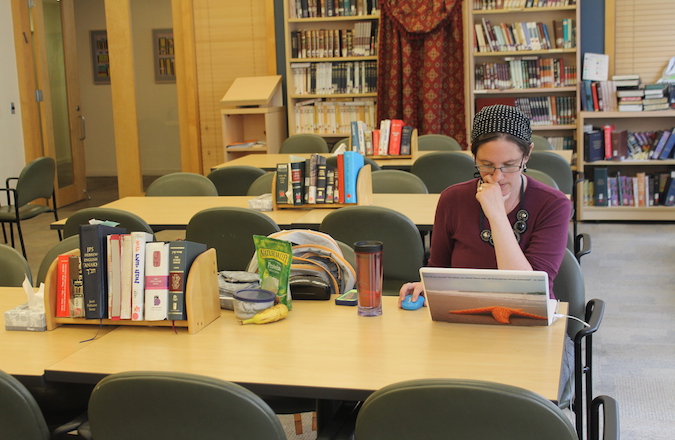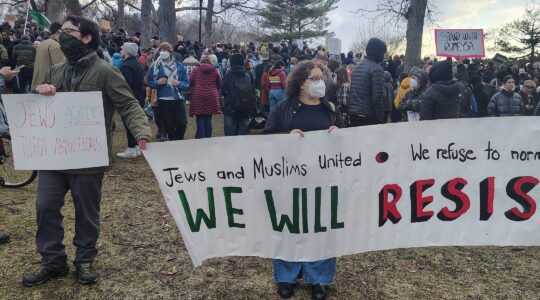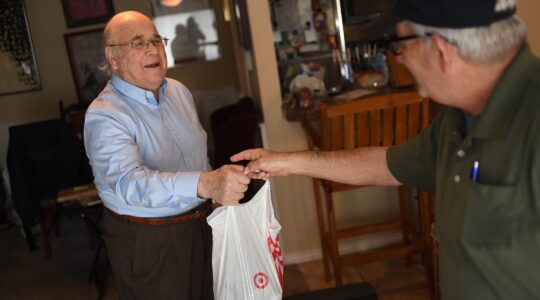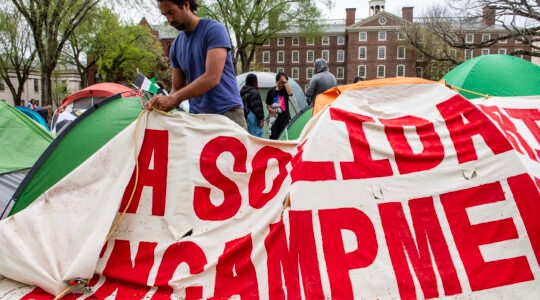NEW YORK (JTA) – When Yeshivat Maharat ordains six women next month, the New York institution will more than double the number of Orthodox clergywomen in the field.
For the past couple of years, the clergywomen have been establishing themselves in Orthodox communities while serving as synagogue interns, delivering sermons, preparing bar and bat mitzvah students, and offering pastoral counseling to congregants. Many of them have found professional homes in synagogues led by disciples of Rabbi Avi Weiss, who founded Yeshivat Maharat in 2009 as an Orthodox rabbinical school for women.
Yet even as they have found jobs, the maharats and the institutions they serve are grappling with how to define their roles as clergywomen in a movement that still does not accept women as rabbis.
“We recognize that the path toward female leadership is slow and is an evolution, and part of the mission of Yeshivat Maharat is to open communities up to the possibilities of women serving in leadership positions,” said Sara Hurwitz, the dean of Yeshivat Maharat and the woman Weiss ordained in 2009 as a “rabba” — a feminized version of rabbi. “We know that there are parts of the Orthodox community that are not open and not ready for Orthodox female leadership, but many are.”
Of the five women who have been ordained by the yeshiva – three in 2013 and two last year – four are working in synagogues, serving essentially as assistant rabbis. (The fifth is a Jewish educator in Montreal.)
“The rabbi and I have a great relationship; we share a lot of the responsibilities,” said Rori Picker Neiss, a maharat who works at Bais Abraham, a modern Orthodox congregation in St. Louis. “We switch off who gives the drasha [sermon] every week, I teach classes, I’m available for counseling, I coordinate some of the programs. I have not yet done funerals or weddings, but I can. My job description would parallel an assistant rabbi’s position.”
Like the rest of the maharats, however, Neiss is not called an assistant rabbi. Her title is director of programming, education and community engagement.
What to call these clergywomen is a hotly contested issue. The yeshiva’s title of choice is maharat, which was coined by Weiss as a less incendiary label than rabbi or rabba. The term is an acronym for the Hebrew words meaning a leader in Jewish law, spirituality and Torah. But most Orthodox Jews are unfamiliar with the term, and plenty of Orthodox institutions are unwilling to recognize female clergy in any iteration. Even many that do find the maharat designation problematic.
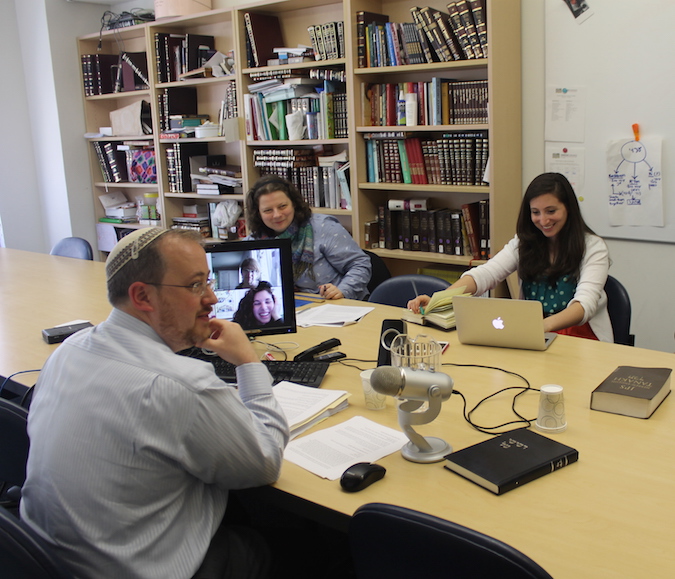
Rabbi Jeffrey Fox, rosh yeshiva of Yeshivat Maharat, teaching a class in Jewish law to the seminarians. (Uriel Heilman)
The modern Orthodox Los Angeles high school Shalhevet offered a job recently to Ramie Smith, one of the women set to be ordained next month by Yeshivat Maharat, but the job reportedly fell through after the school refused to agree to call her maharat. Smith declined to discuss the details of the failed job offer.
“Yeshivat Maharat is ordaining women as spiritual leaders,” she told JTA. “Outside of New York people are still getting to know us. We’re introducing them to a concept.”
Another imminent graduate of the yeshiva, Alissa Thomas-Newborn, was just hired for a new clergy position at B’nai David-Judea, a modern Orthodox congregation in Los Angeles where she has been interning over the last year. But that congregation, too, eschews the maharat title; the shul will address Thomas-Newborn as “morateinu” – Hebrew for “our teacher.”
“One of the most interesting questions that we engaged was by what title we would now begin calling Alissa,” the synagogue’s rabbi, Yosef Kanefsky, said in his Shabbat sermon announcing Thomas-Newborn’s hire. “We sought a title which communicated communal leadership, conveyed spiritual leadership, and which emanated from Judaism’s deepest soul.”
Many of the synagogues that have hired maharats are closely associated with Weiss. Kanefsky is a former associate rabbi at Weiss’ Bronx shul, the Hebrew Institute of Riverdale. So is the rabbi at the Washington synagogue that employs 2013 Maharat graduate Ruth Balinsky Friedman. Another maharat graduate, Victoria Brelow, works at a congregation in California led by a graduate of Yeshivat Chovevei Torah, the rabbinical school for men that Weiss founded in 2000 as a liberal alternative to Yeshiva University’s rabbinical seminary.
Hurwitz, who is on the clergy staff at Weiss’ synagogue, says she hopes that the women graduating from the yeshiva today eventually may become senior rabbis in their own right.
“We would love to see women become the sole clergyperson in a synagogue,” Hurwitz said. “Some of our current students have that goal in mind.”
In a movement where gender roles remain distinct, Orthodox female clergy face some unique challenges. For one thing, they can’t count for a minyan (the quorum of 10 men required for prayer services), lead services or serve on a Jewish religious court, or beit din. Even in synagogues that have welcomed maharats as visiting scholars, many will not allow a woman to ascend to the pulpit during services to deliver a sermon. In those cases, the sermon may be deferred to the end of services or delivered from the women’s side of the sanctuary rather than from the pulpit itself.
But the spiritual work that comprises the bulk of a rabbi’s work can be done just as well by a woman as by a man – and women can offer added value, the maharats say.
“This is my definition of a female rabbi in Orthodoxy: To be competent on the same level as my male colleagues and deal with issues that my male colleagues would not be as experienced to deal with,” said Miriam Gonczarska, a native of Poland set to be ordained by Yeshivat Maharat next month.
“Sometimes being a female helps you reframe situations – both pastorally, but also in framing halachic discourse,” she said. “It may or may not affect the outcome, but it’s an important part of the process.”
The curriculum at Yeshivat Maharat is modeled on that of a rabbinical school, with a strong focus on Jewish law and Talmud study and plenty of pastoral training. The program also tries to prepare the women for the challenges they’ll face as female Orthodox leaders.
“The program in Yeshivat Maharat is a responsible program for responsible leadership – halachic but also social and emotional and feminist,” said Anat Sharbat, an Israeli who will be ordained next month. “We acquire knowledge and halachic skills, and we also learn pastoral studies where we encounter social sensitivities.”
The yeshiva is in the midst of a transition. It is currently housed at the Drisha Institute for Jewish Education, a women’s Jewish learning center on Manhattan’s Upper West Side, but will be moving in the fall to Weiss’ synagogue in the Riverdale section of the Bronx. Some of its 20 students participate remotely, via videoconferencing, but next fall the school will require all students to be on site for the weekday program.
A few of the students who have spent significant time studying elsewhere have been allowed to fast-track their studies by filling in the gaps and taking the exams, but most students go through the entire four-year program. Tuition is free, and students receive a stipend of $10,000 to $12,000 per year.
The yeshiva’s annual budget is under $1 million and is funded largely by family foundations.
Yeshivat Maharat is expecting six to eight new students in the fall.
JTA has documented Jewish history in real-time for over a century. Keep our journalism strong by joining us in supporting independent, award-winning reporting.
